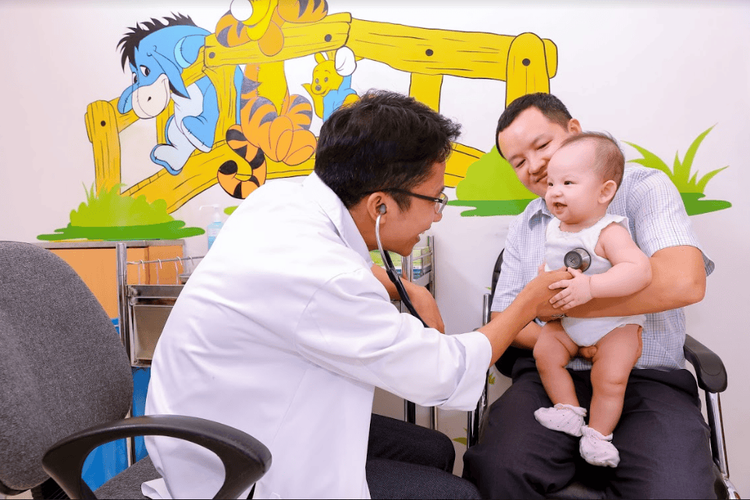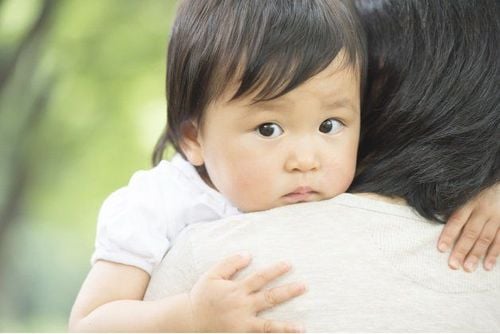This is an automatically translated article.
Nausea is the feeling of wanting to vomit, but the actual vomiting has not occurred. Vomiting and nausea are fairly common symptoms that can occur at any age and have many different causes. Unlike older children, infants with nausea cannot communicate with adults, so the infant's signs of wanting to vomit are often overlooked.
1. Causes of Nausea in Babies
Determining the cause of nausea and vomiting in infants must be based on many different specific factors. Common causes of infant nausea or even vomiting include:
1.1 Pathological causes Acute viral gastroenteritis Gastroesophageal reflux disease Congenital pyloric stenosis Obstruction intestines (eg, bowel obstruction, intestinal volvulus, intestinal strictures), ... 1.2 Mistakes in feeding and care Feeding babies in the wrong position, improper latching on the nipples, leading to a condition Ingestion of a lot of gas into the stomach causes the infant to have nausea and vomiting. Feed your baby an excessive amount at each feeding. Place the baby to lie down immediately after a full feed. Umbilical cords, diapers, and towels that are too tight can also cause nausea and vomiting in babies. Children move a lot during and immediately after eating, ...
2. Signs that an infant wants to vomit
Older children can tell us when they are sick or feel like vomiting. However, young children, especially infants with nausea cannot do this, but if parents pay attention, parents can recognize them through the following signs:
The baby is crying, sucking poorly or refusing to feed, stomach distended, bowel loops visible. Newborns who want to vomit have symptoms of abdominal muscle spasms and are close to actual vomiting. Nausea in infants is often accompanied by autonomic signs such as increased heart rate and increased salivation. Irritation, asphyxia, and respiratory signs (eg, stridor, wheezing) may indicate an infant's urge to vomit due to GERD. Newborns with nausea may have other accompanying signs such as pale skin or unwell child, constipation, diarrhea, ....

Trẻ sơ sinh bị nôn với biểu hiện quấy khóc và bụng chướng
3. Danger warning signs when babies have nausea and vomiting
Nausea and vomiting is a defense mechanism for babies, helping to eliminate potential disease-causing toxins, however, it can also be a sign of serious illness. An infant who wants to vomit or an infant with vomiting accompanied by one of the following problems should be taken to a medical facility for a health check:
Vomiting profusely, vomiting in 2 consecutive meals or vomiting for more than 3 times/day. Children's lips and mouth are dry, eyes sunken due to dehydration. The child has a fever and signs of infection. Recurrent vomiting or vomiting of bile (yellow or green) or severe vomiting often suggest a gastrointestinal obstruction that requires intervention. Be especially vigilant when infants vomit with prior trauma to the head, have signs of stiff neck, difficulty breathing, somnolence, ... it may be vomiting due to increased intracranial pressure, which is very dangerous.
4. Dealing with Nausea and Vomiting in Newborns
Antiemetics are commonly used in adults to relieve nausea and prevent vomiting. In children with nausea and vomiting is rarely indicated and only used in children 2 years of age and older because of the risk of side effects, unclear efficacy, and masking of the disease. background.When an infant has nausea and vomiting, if there are no serious warning signs that require medical intervention mentioned above, priority should be given to rehydration (if vomiting occurs), then seek medical attention. Finding and solving the cause of the disorder:4.1 If the infant has nausea and vomiting due to a medical condition: Take the child to a medical facility for examination for appropriate specialist treatment.

Trẻ sơ sinh bị nôn do bệnh lý thì cha mẹ cần đưa trẻ tới gặp bác sĩ trong thời gian sớm
4.2 If the infant has nausea and vomiting due to improper feeding and care: Need to change the care routine and feeding method:
Adjust the position for the infant to properly latch on to the breast. If bottle-feeding, tilt the bottle so that the milk fills the new nipple for the baby to latch on. Divide feedings into several meals. Elevate the baby's head during and after feeding. Burp your baby after feeding. Avoid wrapping diapers and towels too tightly after your baby is full. Gently rub around the navel and abdomen to help reduce stomach spasms, improve intestinal motility, help children excrete stools daily, reduce bloating. If an infant has persistent nausea, other therapies such as music therapy can be used to distract the infant.
Thus, the reaction of nausea and vomiting can help an infant remove toxins from the body, but it can also be a symptom of medical conditions, or a manifestation of parents not taking care of the child. it's correct. Because of the inability to communicate, infants with nausea are often overlooked, which poses many risks to the child. Parents need to improve their knowledge of health, learn how to properly care for their newborn to detect abnormalities early for timely treatment, and help children achieve good health and optimal development.
Please dial HOTLINE for more information or register for an appointment HERE. Download MyVinmec app to make appointments faster and to manage your bookings easily.













